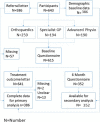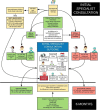Using routine referral data for patients with knee and hip pain to improve access to specialist care
- PMID: 32013997
- PMCID: PMC6998102
- DOI: 10.1186/s12891-020-3087-x
Using routine referral data for patients with knee and hip pain to improve access to specialist care
Abstract
Background: Referral letters from primary care contain a large amount of information that could be used to improve the appropriateness of the referral pathway for individuals seeking specialist opinion for knee or hip pain. The primary aim of this study was to evaluate the content of the referral letters to identify information that can independently predict an optimal care pathway.
Methods: Using a prospective longitudinal design, a convenience sample of patients with hip or knee pain were recruited from orthopaedic, specialist general practice and advanced physiotherapy practitioner clinics. Individuals completed a Knee or hip Osteoarthritis Outcome Score at initial consultation and after 6 months. Participant demographics, body mass index, medication and co-morbidity data were extracted from the referral letters. Free text of the referral letters was mapped automatically onto the Unified Medical Language System to identify relevant clinical variables. Treatment outcomes were extracted from the consultation letters. Each outcome was classified as being an optimal or sub-optimal pathway, where an optimal pathway was defined as the one that results in the right treatment at the right time. Logistic regression was used to identify variables that were independently associated with an optimal pathway.
Results: A total of 643 participants were recruited, 419 (66.7%) were classified as having an optimal pathway. Variables independently associated with having an optimal care pathway were lower body mass index (OR 1.0, 95% CI 0.9 to 1.0 p = 0.004), named disease or syndromes (OR 1.8, 95% CI 1.1 to 2.8, p = 0.02) and taking pharmacologic substances (OR 1.8, 95% CI 1.0 to 3.3, p = 0.02). Having a single diagnostic procedure was associated with a suboptimal pathway (OR 0.5, 95% CI 0.3 to 0.9 p < 0.001). Neither Knee nor Hip Osteoarthritis Outcome scores were associated with an optimal pathway. Body mass index was found to be a good predictor of patient rated function (coefficient - 0.8, 95% CI -1.1, - 0.4 p < 0.001).
Conclusion: Over 30% of patients followed sub-optimal care pathway, which represents potential inefficiency and wasted healthcare resource. A core data set including body mass index should be considered as this was a predictor of optimal care and patient rated pain and function.
Keywords: Care pathway; Hip; Knee; Musculoskeletal; Text mining.
Conflict of interest statement
The authors declare that they have no competing interests.
Figures
Similar articles
-
What General and Pain-associated Psychological Distress Phenotypes Exist Among Patients with Hip and Knee Osteoarthritis?Clin Orthop Relat Res. 2020 Dec;478(12):2768-2783. doi: 10.1097/CORR.0000000000001520. Clin Orthop Relat Res. 2020. PMID: 33044310 Free PMC article.
-
Does the implementation of a care pathway for patients with hip or knee osteoarthritis lead to fewer diagnostic imaging and referrals by general practitioners? A pre-post-implementation study of claims data.BMC Fam Pract. 2019 Nov 9;20(1):154. doi: 10.1186/s12875-019-1044-2. BMC Fam Pract. 2019. PMID: 31706277 Free PMC article.
-
Musculoskeletal care pathways for adults with hip and knee pain referred for specialist opinion: a systematic review.BMJ Open. 2019 Sep 4;9(9):e027874. doi: 10.1136/bmjopen-2018-027874. BMJ Open. 2019. PMID: 31488471 Free PMC article.
-
RECOVER-E - a mobile app for patients undergoing total knee or hip replacement: study protocol.BMC Musculoskelet Disord. 2020 Feb 4;21(1):71. doi: 10.1186/s12891-020-3090-2. BMC Musculoskelet Disord. 2020. PMID: 32019529 Free PMC article.
-
Are the Effects of Resistance Exercise on Pain and Function in Knee and Hip Osteoarthritis Dependent on Exercise Volume, Duration, and Adherence? A Systematic Review and Meta-Analysis.Arthritis Care Res (Hoboken). 2024 Jun;76(6):821-830. doi: 10.1002/acr.25313. Epub 2024 Apr 15. Arthritis Care Res (Hoboken). 2024. PMID: 38317328
Cited by
-
MulTI-domain self-management in older People wiTh OstEoarthritis and multi-morbidities: protocol for the TIPTOE randomised controlled trial.Trials. 2024 Aug 23;25(1):557. doi: 10.1186/s13063-024-08380-7. Trials. 2024. PMID: 39180101 Free PMC article.
-
Diagnosing knee osteoarthritis in patients, differences between general practitioners and orthopedic surgeons: a retrospective cohort study.BMC Prim Care. 2023 Aug 1;24(1):155. doi: 10.1186/s12875-023-02107-4. BMC Prim Care. 2023. PMID: 37528362 Free PMC article.
-
Impact of digital interdisciplinary consultation on secondary care referrals by general practitioners: a protocol for a stepped-wedge cluster randomised controlled trial.BMJ Open. 2022 Dec 1;12(12):e060222. doi: 10.1136/bmjopen-2021-060222. BMJ Open. 2022. PMID: 36456003 Free PMC article.
-
Patient Triage by Topic Modeling of Referral Letters: Feasibility Study.JMIR Med Inform. 2020 Nov 6;8(11):e21252. doi: 10.2196/21252. JMIR Med Inform. 2020. PMID: 33155985 Free PMC article.
References
-
- NICE . Osteoarthritis: care and management | guidance and guidelines | NICE [Internet]. Vol. CG177. London: NICE; 2014.
-
- Government WA . A healthier Wales: our plan for health and social care. 2018.
-
- Arthritis Research U . Providing physical activity interventions for people with musculoskeletal conditions. 2018.
MeSH terms
Grants and funding
LinkOut - more resources
Full Text Sources




